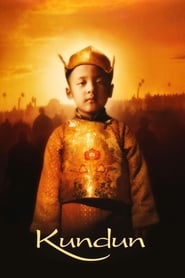Kundun is one beautiful scene after another. Yet it's the same message in each shot: the Dalai Llama is very humble and noble; child God-kings are a great idea, actually; this is actually a perfect country that's only in need of some 'reforms'; his political naivete is actually a virtue in Cold War politics; and the Chinese are either Very Bad or just biding their time until their duplicitous is revealed. No doubt there's more than a kernel of truth in all that, but viewing this all through a single person (even if they are singularly pivotal) doesn't make for an effective aesthetic analysis of such a complicated, multifactorial historical situation.
I liked the opening nod to Jean Renoir's The River (1951), if only if this was a silent acknowledgement that this was a film made by a cultural outsider and would thus have a Western gaze — it's hardly The Color of Pomegranates (1969) in that respect, however. But then I'm not quite sure what point was being made by the reference to Gone With The Wind's famous crane shot? That the annexation of Tibet by China is some kind of lost cause and Chamdo the new Atlanta?
Elbert Ventura wonders: "Is there not a fundamental mismatch in style and content here? Is Scorsese’s restless eye, so suited for New York and the present day, too frenetic for a movie like this?" I think this is a valid question in relation to Kundun, yet after the release of Killers of the Flower Moon, it would of course require a reanalysis which took into account Scorcese's personal evolution, the changes in the world since 1997, and the very fact that Scorcese is likely a fairly good critic of his previous work.
In a way, Kundun is structured like one of the many Buddhist sand mandalas that Scorsese captures on screen, creating intricate narrative lines that weave in and out of each other to yield something that feels like one unbroken image. [Indeed], Kundun’s editing [Thelma Schoonmaker] perhaps does more to define the Dalai Lama than any of the actors who play him. Scorsese’s films tend to concern protagonists whose narcissism blinds them to how little power they actually have, but Kundun inverts this dynamic by centering itself around a hero who, at a very young age, is bestowed tremendous authority, and who fears his unworthiness to wield it.
— Jake Cole (Slant Magazine)
Kundun is like one of the popularized lives of the saints that Scorsese must have studied as a boy in Catholic grade school. I studied the same lives, which reduced the saints to a series of anecdotes. At the end of a typical episode, the saint says something wise, pointing out the lesson, and his listeners fall back in amazement and gratitude. The saint seems to stand above time, already knowing the answers and the outcome, consciously shaping his life as a series of parables.
Since I barely remember Kundun today, I’m pretty sure I must have overrated it.
You can’t blame Scorsese for treading lightly—he is depicting, after all, another people’s religion and beloved leader. But while the reverence is understandable, the effect is sometimes akin to spiritual tourism. It’s a movie that’s respectful to a fault, unable and unwilling to dig beneath the surface. There’s a remoteness to Kundun that isn’t quite fatal, but it can feel like watching a religious pageant from behind glass.
— Elbert Ventura (Reverse Shot)
Synopsis: The Tibetans refer to the Dalai Lama as 'Kundun', which means 'The Presence'. He was forced to escape from his native home, Tibet, when communist China invaded and enforced an oppressive regime upon the peaceful nation. The Dalai Lama escaped to India in 1959 and has been living in exile in Dharamsala ever since.

